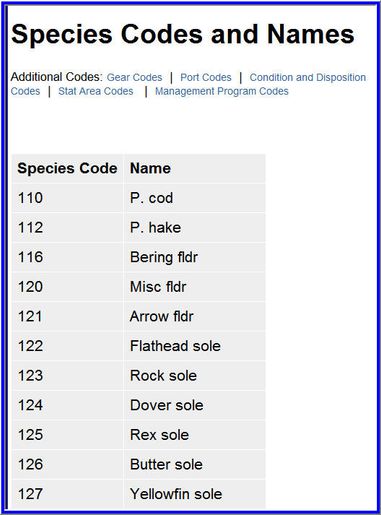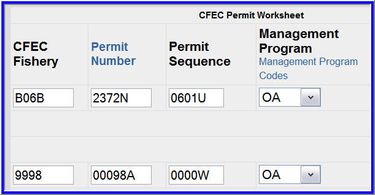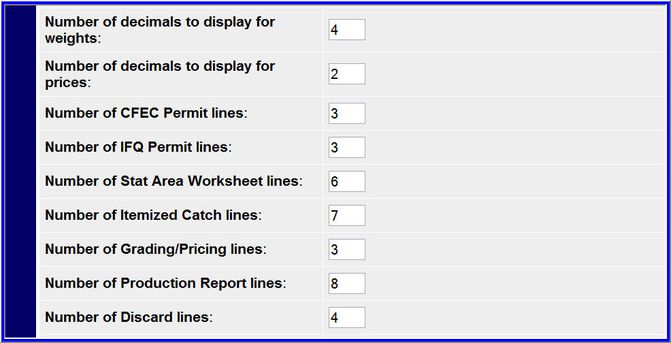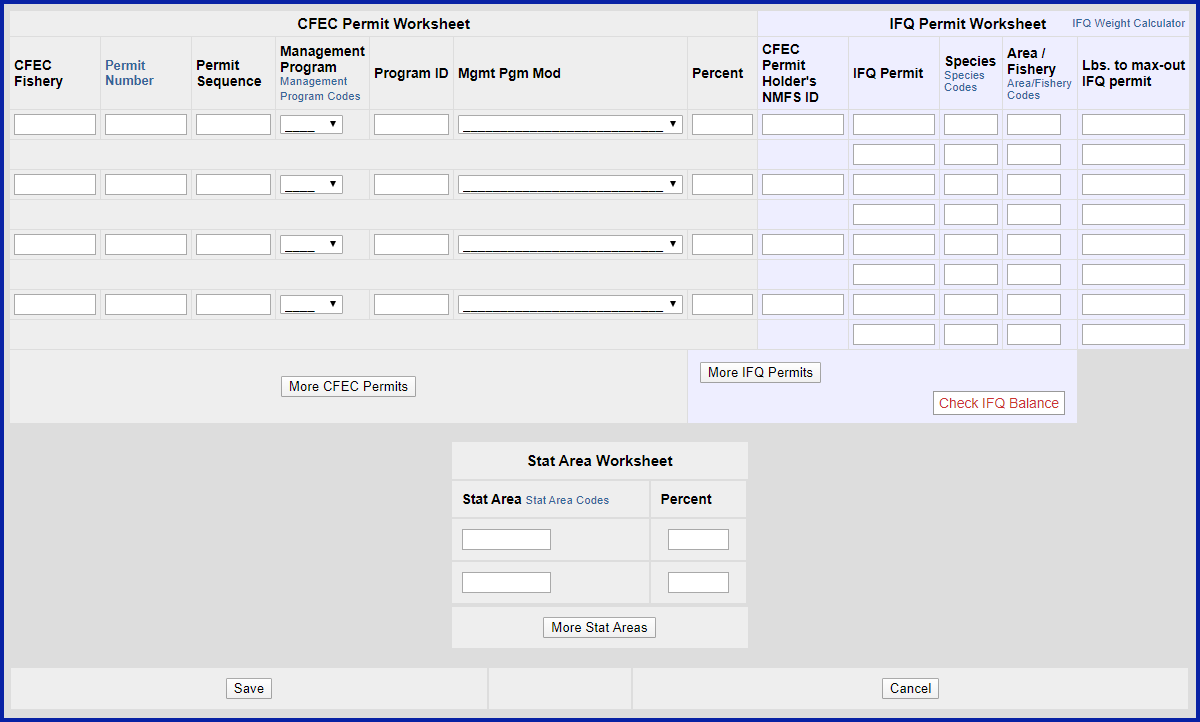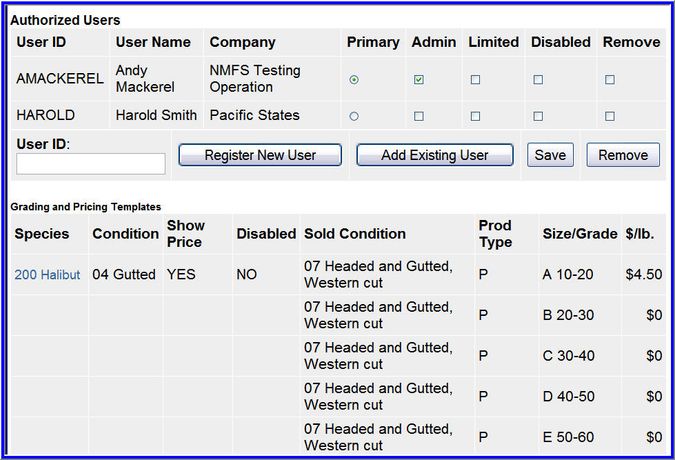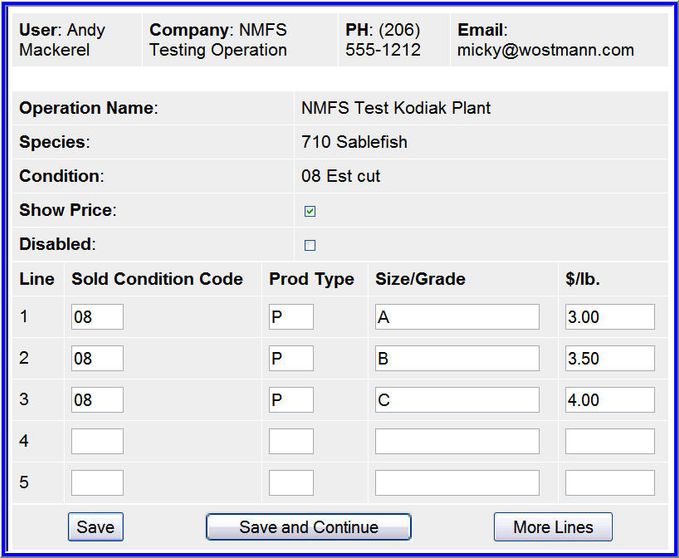eLandings User Manual
Application Features
Application Features
The internet platform for eLandings provides many features that will make accurate recording of required landing and production easier. Processors and buyers that use eLandings for record keeping and reporting will have immediate access to the electronic version of the report for review, modification, and re-submission. The most important eLandings application feature is the ability to record and submit a report of all harvest off-loaded to your facility from the vessel, irrespective of the number of permit holders. In other words, in the past, an off-load with several stacked permits would generate multiple fish ticket reports. This situation usually occurs with IFQ fisheries. Using eLandings, you will be able to document the full off-load as a landing report. eLandings generates the appropriate fish tickets for the situation. The fish ticket(s) generated with eLandings are .PDF files ready for printing, signature, and distribution to the CFEC permit holder and ADF&G. Each landing report is uniquely numbered.
Throughout this document and within the application, we will refer to the landing report, rather than the fish ticket, as it more accurately reflects the functioning of the eLandings application. Additional features offered with the eLandings application include:
Integrated Reporting
The eLandings application allows users to fulfill off-load record keeping requirements for ADF&G fish tickets, NMFS RAM IFQ reporting, IPHC halibut reporting, and NMFS Inseason Management production reporting for groundfish. Other reporting requirements may apply to you and your operation depending on the type of activities your business is engaged in. The eLandings application fulfills the initial off-load and sale and production of product reporting requirements. All other reporting requirements still apply. Please check with your local office of NMFS, ADF&G and the IPHC Seattle staff to determine additional reporting requirements for your operation.
Saving and Recall Features
The eLandings applications allow you to record and save to the repository database off-load information as it becomes available. At the beginning of an off-load, when the skipper or permit holders are available, you will be able to record and save all the information about who fished, on what vessel, where and when. This information is contained, in part, on the ADF&G fish ticket 'header' (top portion). Once saved, this portion of a landing report is still incomplete. However, as soon as the 'header' information is saved, it is assigned a landing report number and can be recalled. The unsubmitted report can be located and recalled from the Reports Menu page.
When the off-load has been sorted and weighed, the itemized catch can be recorded in eLandings and an initial landing report,including IFQ reporting (if applicable), can be submitted to the Interagency Database.
Landed catch is frequently sorted for grade and size. Pricing information is often not immediately available. When this information is obtained, the landing report can be recalled from the eLandings application. All 'Unsubmitted' and 'Initially Submitted' landing reports are listed and available from the Reports Menu page, Incomplete Landing Reports. Grading and price information can be added, and the landing report submitted to the agencies as the final landing report.
The eLandings application has been designed to meet the business flow of the processor/buyer, and to meet the record keeping requirements of the agencies responsible for oversight.
New Required Information
The eLandings application contains a few new information elements that will need to be provided to successfully submit the landing report. New information elements include:
— Number of Crew, including skipper
— Number of observers on board (NMFS certified groundfish or ADF&G certified crab observers only)
— Management program for the targeted species (e.g., Community Development Quota Program - CDQ, American Fisheries Act Pollock - AFA, State Managed Pacific Cod Fishery - SMPC, Open Access - OA, etc.) — Disposition (Use or disposition of product)
— Last Delivery of Trip (final off-load, empty hull)
The new data requirements are minimal and have resulted in improved reporting efficiency of the eLandings system.
Stacked Permits
Fishers often fish off multiple CFEC permits on the same trip. IFQ stakeholders frequently join together to fish IFQ from the same vessel. This practice is commonly referred to as stacking permits. Using ADF&G paper fish ticket forms, this practice requires the completion of multiple fish tickets. The eLandings application allows the user to record all permits associated with the landing report simultaneously. The total harvest from the fishing trip can also be allocated by percentage using the CFEC Permit Worksheet.
In the example below, three halibut IFQ quota share fishers joined together to fish. The vessel owner sells 60% of the catch and the two IFQ shareholder 'crew' sell 40% of the catch.
An example of a CFEC permit worksheet with multiple permits.
When the landing report is ready to be submitted, the itemized catch is allocated among the permits according to how the percentages were entered. Likewise, the IFQ reports to NMFS are generated from the IFQ permits input and the itemized catch data.
When the landing report is submitted, the eLandings application generates three fish ticket .PDF files. When the IFQ reports have been successfully submitted, the system generates a .PDF file of all the IFQ report receipts. IFQ reporting of stacked permits is streamlined, as all CFEC permits and IFQ permits can be recorded on one landing report.
Online Fishery Codes
Most fishery codes are available on line, including gear,species, statistical area codes with translations from the ADF&G statistical area to the federal reporting area and IPHC regulatory area,delivery condition code, and disposition code. All code tables in the eLandings application can be accessed by clicking on the words in blue text. The blue text is an indicator that the words are linked to additional pages and windows.
Online ReferenceTable of Species Codes and Names
Immediate Data Validation
The reporting sequence requires that the 'header' information - who fished, where, when and on what - is saved. When the itemized catch is available the information is recorded and saved, followed by grading, sizing and pricing information and submission of the IFQ report, if applicable. As each portion of the landing report is submitted to the Interagency Database Server, many data elements are validated to make certain the information is correct. All fishery codes are validated to determine that the codes do exist. CFEC permits, NMFS ID's, and IFQ permits are validated and checked to determine that they are valid for the fishery. Statistical areas, species codes, delivery condition, and disposition codes are validated. Numbers are also checked for sanity. As an example, if you enter $300.00 per pound or three million pounds, the application will warn you to review the data element for correctness.
These immediate data validation features are designed to reduce errors for your business records and for inseason management agencies. If a data element fails validation, the application will indicate the specific element that has failed validation and will provide you with important clues to correct the entry and successfully submit the landing report.
Error Messaging
The eLandings application is designed to provide you with important information on any data element that has failed validation or sanity checks. An example of a sanity check is the sequence between the data elements, Date Fishing Began and Date Landed. If you enter a Date Landed that is prior to the Date Fishing Began, these data elements will fail validation. The application will message back that the Date Landed is a date prior to Date Fishing Began:
If you are entering data into a worksheet, the error messages will tell you where in the worksheet the problem is occurring. For example, this error message indicates that the Permit Number and Year Sequence are not a valid combination.
Sometimes you can get multiple errors at once. These error messages indicate that both the Gear Code and the stat area are not valid.
Additional information is available, for corrective action, by clicking on the blue text, ERROR - #. This opens a detailed error message window. The example below is the message detail with specific information for error 1070.
Interim Values
All data elements must be correctly entered in the eLandings application for the successful submission of a landing report. In very few cases, critical data elements may fail validation restricting the completion of the landing report. Specific fields will allow the user to enter an interim value and continue the reporting process. The interim value must be replaced within 72 hours with the valid ADF&G vessel number or the CFEC permit valid for the fishery and the year. These values are provided to aid processors when an otherwise valid CFEC permit or vessel permit number fails validation. During this time period, the user can contact the local office of ADF&G or NMFS to obtain assistance or to the correct information submitted. Interim values include:
If you have received a landing of fish that needs to be sorted prior to completing the landing report, or held in a tank for a short period of time prior to weighing, please use the general code 120 - General Flatfish** *for all unsorted flatfish and the ***Pollock code - 270*for unweighed Pollock. The eLandings application will allow you to select *estimated weight* in this situation. This feature will allow you to document the landing, make an initial submission of the landing report to the Interagency Server, generate a fish ticket(s), and obtain the signatures for the .PDF fish tickets. When the delivery of fish has been sorted, you can recall the landing report by the unique number and replace the general species code with specific species codes and actual weights. *Processors will be provided 72 hours to replace estimated weights and general flatfish species codes with actual species codes and weights.
Automatic Deduction for Ice/Slime in Halibut and Sablefish Fisheries
The eLandings application allows you to record itemized catch of halibut and/or sablefish, and indicate if ice/slime was present at the point it was weighed. Only vessels that qualify for ice/slime deduction may utilize this application function. Two percent is automatically deducted when ice/slime is selected. This feature is located in the Add/Edit ItemizedCatch section of the eLandings application, under Lbs. Mod (weight modifier), and functions for halibut and sablefish species only.
Customize Your eLandings Account
The eLandings System allows the user to customize the display of the application to facilitate data entry and documentation of reported catch. After you log onto the eLandings System, the application automatically displays the Report Menu page. Note the link to User Profile.
When you select this link, the application displays information associated with this user account. Below the contact information, is a listing of web display feature options.
You can control the display of data fields to better meet the needs of your reporting requirements and your operation. As an example,you might determine that you need to have three CFEC permit lines consistently displayed and two statistical areas. To establish a display like the one illustrated below, simply select, Number of CFEC Permit Lines = 2 and Number of Stat Area Worksheet lines = 2.
The eLandings System also allows the Administrative User to add and restrict rights to additional users within a company or operation, and to set grading/sizing/pricing defaults.
Additional information on these features is provided in the User Account section of this document.




